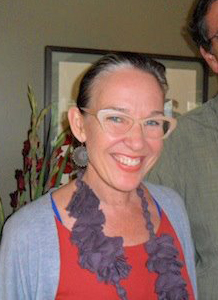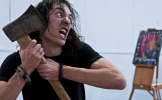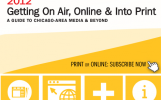Posted by Jennifer Rapp Peterson
Elizabeth Burke-Dain co-founded Chicago’s Around the Coyote Arts Festival in 1989. Since then she has been in the business of promoting artists and art events in Chicago. I remember meeting Elizabeth Burke with her then artist boyfriend, Michael Dain (Bif) at bar listening to a mutual friend’s band, Shrimp Boat. We shared drinks and a lot of laughter. While I promoted nightclubs (planned and hosted parties), she promoted artists and started Around the Coyote.
 Around the Coyote exhibited local and emerging artists in and around the Flatiron Building in the Wicker Park neighborhood of Chicago. Artists’ studios were made accessible to the public, which opened up the arts to a new audience and launched numerous art careers. In 1989, Wicker Park had not been gentrified and hosted a vibrant arts community. As Wicker Park became a more expensive place to live, many artists were forced to live outside the neighborhood. And, after 20 years, Around the Coyote finally closed in 2010.
Around the Coyote exhibited local and emerging artists in and around the Flatiron Building in the Wicker Park neighborhood of Chicago. Artists’ studios were made accessible to the public, which opened up the arts to a new audience and launched numerous art careers. In 1989, Wicker Park had not been gentrified and hosted a vibrant arts community. As Wicker Park became a more expensive place to live, many artists were forced to live outside the neighborhood. And, after 20 years, Around the Coyote finally closed in 2010.How did you learn how to market artists?
Around the Coyote was not a curated exhibition, but was meant to showcase working artists in Chicago by inviting the public into their private workspaces. I think the marketing part was more about just creating an opportunity for artists, any artist good or bad, to open up their studios and educate the public about what it looks and feels like to be an artist in Chicago. I think this was a big part of Around the Coyote’s popularity. It was kind of an ‘aha’ moment for people who were unaware of just how abundant the arts community was on a grassroots level.
I didn’t think that I was marketing artists. Around the Coyote wasn’t about the market at all. It was born out of my love for all my friends who were and continue to be artists and my ability to create an event framework for them.
Appreciating art in all of its permutations, conceptions, arguments and misunderstandings is part of why I like it so much. It has a tension that I find very exciting. Art is a dialog with the culture. It is an ongoing conversation that you can pick up on the thread of at any point in history. Artworks are only a part of the conversation. There are curators, critics, galleries, museums, tastemakers and arbiters who shine a light on artists whom they think capture the contemporary moment, but art making and the act of creativity is never a futile act.

Photo courtesy of greenlantern.org. Green Lantern was part of Wicker Park’s annual arts fair, Around the Coyote, Green Lantern hosted artists, Brian Collier and Stephen Eichorn
So how did you end up in the PR department at Columbia?
I left the Art Institute of Chicago in 1994. In 1995 I had my first child. After having my own fundraising event company, Function, for ten years a friend, told me about an open position in the Public Relations department at Columbia College. I interviewed for the job and got it. They were very impressed that I was the founder of Around the Coyote. Finally, my work had paid off.
It was a dream job – a real art job. I was to work with Columbia College’s six professional galleries and promote their exhibitions to the press. While at Columbia I started a pretty impressive art collection. Luckily, many of the artists who were curated into exhibitions sold their work at prices I could afford.
What was your favorite part of the job?
My favorite part of the job was sitting on the curatorial review boards for each of the galleries. I got to curate a couple of shows. I recommend that anybody who wants to do anything in the visual arts as an artist or an administrator should curate an art exhibition.
What is your #1 tip for new artists interested in taking their art career/business to the next level?
Well, I guess it depends on what “the next level” means. If you’re shooting to be an art star; move to LA, abandon all meaningful personal relationships and get ready to eat, drink and breathe your own sense of self-importance. (Just kidding. I don’t know the recipe for becoming an art star, but I’ll bet that this advice is not far off. Try it, it might just work fer ya.)
Curate a show. But, do not curate yourself into the show you are curating! It’s considered very bad form. Even though you cannot curate yourself into your own show, curating your own exhibition gives you the opportunity to ask artists you really respect to work with you. It also gives you the chance to find out how to write a curatorial statement and see what goes into organizing a group exhibition. One place to look is any college with a professional art gallery. They usually solicit curators and will provide guidelines for you to make a proposal.
Also, be prepared to stay focused on your art for a long (long) time. Let the muse know that you mean business. If you want to move to the next level, follow your gut. If you think you want to be represented by a gallery, go to your favorite gallery and show them your work. If you want to sell your work on your own, establish an online presence and work all of the social media platforms to get your work out there. Ask your favorite blogs to write about you. Show up at openings. Be public. Make friends with artists and dealers. Get somebody to buy your work and let everybody know that “you’re in a collection." Make business cards with your website or blog on it. Get in people’s faces in a way that makes sense for you.
What are you working on now?
Right now I’m writing an art review of Surface International magazine and I’m promoting a Guerrilla Girls exhibition that is opening at Columbia College Chicago in March and April. I am writing for a few design blogs. I’m also dreaming of a smart phone app that I’d like to develop, but not ready to talk about.
May people contact you or hire you?
They can contact me at eburkedain@gmail.com. I am available to promote exhibitions and other art or design-related projects.
Other Similar Content
Resource category




